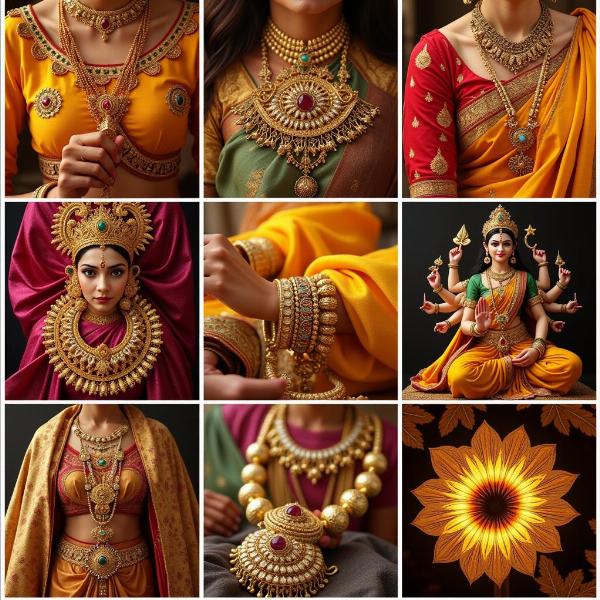Lustrous, a word often used to describe something shining or radiant, has a rich equivalent in Hindi. Understanding the nuances of this term can be valuable for anyone seeking to expand their Hindi vocabulary or gain a deeper appreciation of Indian culture. What exactly does “hindi meaning of lustrous” entail, and how is it used in different contexts?
Exploring the Hindi Equivalents of Lustrous
The Hindi meaning of lustrous isn’t confined to a single word. The richness of the language offers several beautiful and evocative options, each with its own subtle shade of meaning. Some common translations include “chamakdar” (चमकदार), “damakdar” (दमकदार), and “ujjwal” (उज्जवल). While all these words convey the idea of shine, they are used in slightly different ways.
“Chamakdar” (चमकदार) describes a bright, sparkling shine, often associated with objects like polished metal or gemstones. “Damakdar” (दमकदार), on the other hand, suggests a more subdued, glowing radiance, like that of a healthy complexion or a polished wooden surface. “Ujjwal” (उज्जवल), meanwhile, carries a connotation of brilliance and splendor, often used to describe things of great beauty or importance. Understanding these subtle differences can help you choose the most appropriate word in a given context. Think about the specific kind of shine you want to describe – is it a bright sparkle, a soft glow, or a magnificent radiance?
Lustrous in Indian Culture and Literature
The concept of luster plays a significant role in Indian culture and literature. From the shimmering silks worn during festivals to the descriptions of radiant deities in ancient texts, the idea of shine is deeply intertwined with beauty, purity, and divinity. In Hindu mythology, for example, the goddess Lakshmi, the embodiment of wealth and prosperity, is often depicted with a lustrous complexion, symbolizing her divine radiance. Similarly, the lustrous sheen of precious metals like gold and silver is associated with prosperity and good fortune.
 Lustrous in Indian Culture
Lustrous in Indian Culture
Lustrous Hair: A Symbol of Beauty
In India, lustrous hair is considered a sign of health and beauty. Traditional remedies and practices often focus on enhancing the natural shine of hair, using ingredients like coconut oil and amla. This emphasis on lustrous hair reflects the cultural significance of beauty and well-being. Perhaps you’re looking for the hindi meaning of hair to further your understanding.
Choosing the Right Word: Context is Key
Choosing the right Hindi word for lustrous depends heavily on the context. For instance, while “ujjwal” might be suitable for describing a glorious sunset, “chamakdar” might be more appropriate for a shiny new car. Consider the object or concept you’re describing and the specific type of shine you want to convey.
What if something isn’t shiny?
Understanding the opposite of lustrous is also important. The non luminous meaning in hindi can be expressed through words like “phika” (फीका), meaning dull or faded, or “matt” (मैट), which refers to a non-reflective surface. This contrast further emphasizes the importance of luster and shine in Indian culture.
Conclusion: Beyond the Shine
Understanding the hindi meaning of lustrous opens up a window into the rich tapestry of Indian language and culture. From the shimmering silks to the radiant deities, the concept of shine holds a special significance. By appreciating the nuances of words like “chamakdar,” “damakdar,” and “ujjwal,” you can gain a deeper understanding of the language and its cultural context. Perhaps you’d like to explore the meaning of lustrous in hindi further. Or maybe you’re interested in the dipti meaning in hindi, as “dipti” also relates to brilliance and radiance.
FAQ
-
What is the most common Hindi word for lustrous? “Chamakdar” (चमकदार) is arguably the most commonly used word for lustrous.
-
How is “damakdar” different from “chamakdar”? “Damakdar” suggests a softer glow, while “chamakdar” implies a brighter sparkle.
-
What is the Hindi word for dull or non-lustrous? Words like “phika” (फीका) and “matt” (मैट) are used to describe non-lustrous surfaces.
-
Why is lustrous hair considered important in Indian culture? It is seen as a sign of health, beauty, and well-being.
-
Which word should I use to describe a radiant sunset? “Ujjwal” (उज्जवल) would be a fitting choice for a radiant sunset.
Meaning-Hindi.in is your premier destination for professional Hindi translation services. We offer a wide range of specialized translation solutions, from business and legal documents to technical manuals and website localization. Our team of expert linguists ensures accurate and culturally sensitive translations, tailored to your specific needs. Contact us today for a free quote! Email: [email protected], Phone: +91 11-4502-7584. Meaning-Hindi.in is your trusted partner for bridging the language gap.